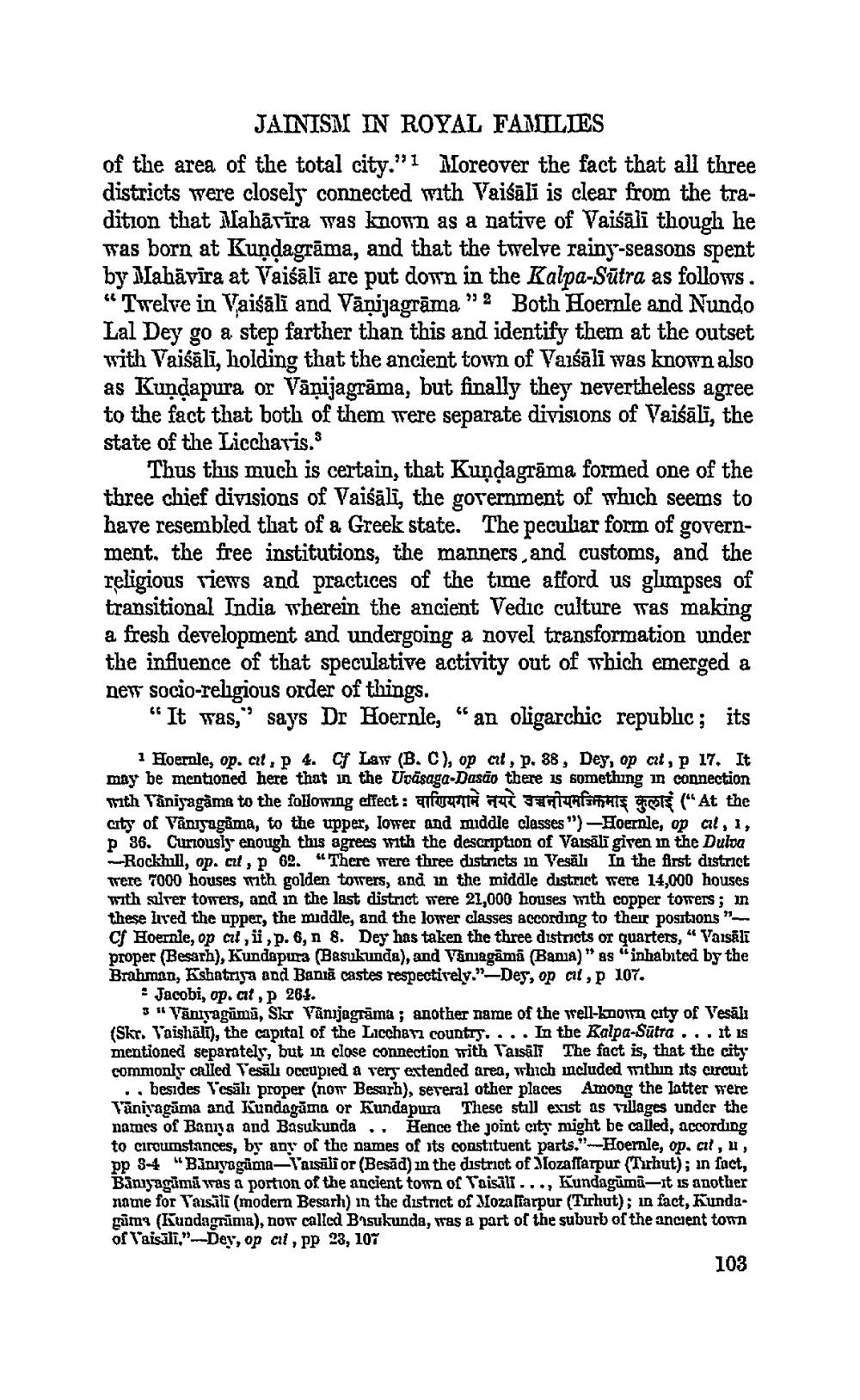________________ JAINISM IN ROYAL FAMILIES of the area of the total city."I Moreover the fact that all three districts were closely connected with Vaisali is clear from the tradition that Maharira was known as a native of Vaisali though he was born at Kundagrama, and that the twelve rainy-seasons spent by Dahavira at Vaisali are put down in the Kalpa-Sutra as follows. "Twelve in Vaisali and Vanijagrama" 2 Both Hoernle and Nundo Lal Dey go a step farther than this and identify them at the outset with Vaisali, holding that the ancient town of Vazsali was known also as Kundapura or Vanijagrama, but finally they nevertheless agree to the fact that both of them were separate divisions of Vaisali, the state of the Liccharis. Thus thus much is certain, that Kundagrama formed one of the three chief divisions of Vaisali, the government of which seems to have resembled that of a Greek state. The peculiar form of government. the free institutions, the manners and customs, and the religious views and practices of the time afford us glimpses of transitional India wherein the ancient Vedic culture was making a fresh development and undergoing a novel transformation under the influence of that speculative activity out of which emerged a new socio-religious order of things. "It was," says Dr Hoernle, "an oligarchic republic; its 1 Hoernle, op. cit, 4. Of Law (B.C), op at, p. 88, Dey, op cit, P 17. It may be mentioned here that in the Uvasaga-Dascio there is something in connection with Taniyagama to the following effeet: वाणियगाने नयरे उच्चनीयमजिकमाइ कुलाई ("At the city of Vinyagima, to the upper, lower and middle classes ") - Hoernle, op al, 1, p 86. Curiously enough this agrees with the description of Varsali given in the Duloa Rockhull, op. cit, p62. There were three districts in Vesali In the first district Tere 7000 houses with golden towers, and in the middle district were 14,000 houses with silver towers, and in the last district were 21,000 houses with copper towers; in these lived the upper, the middle, and the lower classes according to their positions - C Foernie, op cal,u , p. 6, n 8. Dey has taken the three districts or quarters, " Vaisali proper (Besarh), Kundapura (Basukunda), and Vanagami (Bana)" as "inhabited by the Brahman, Kshatriya and Bania castes respectively." --Dey, op cit, p 107. Jacobi, op. cit,p 264. ** Vaniyagami, Skr Vanijograma; another name of the well-kno1n city of Vesali (Skr. Yaishalt), the capital of the Licchat country. ... In tbe Kalpa-Sutra ... It is mentioned separately, but in close connection with Taisali The fact is, that the city commonly called Vesali occupied a very extended area, which included within its circut .. besides Vesali proper (not Besarh), several other places Among the latter were Vanivaguma and Kundogama or kundapura These still exist as villages under the names of Bannya and Basukunda .. Hence the joint city might be called, according to circumstances, by any of the names of its constituent parts."-Hoernle, op. cit, , pp 8-4 "Biniyogama-lausuli or (Besad) in the district of lozaffarpur (Thrhut); in fact, Banyagama vas a portion of the ancient town of Voisali . . ., Kundagimi-It is another name for Taisali (modern Besarh) in the district of Jozaffarpur (Tirhut); in fact, Kundagims (Kundagrima), not called Basukunda, mas a part of the suburb of the ancient town of Vaisali,"Dey, op cit, pp 23, 107 103




